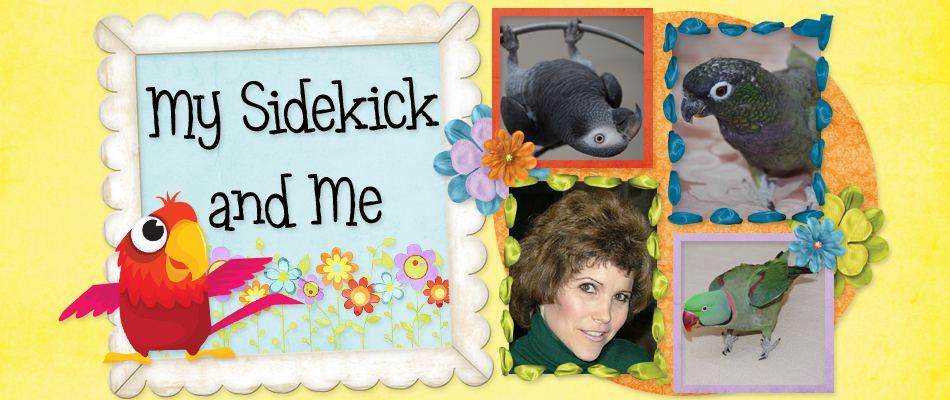
Barnaby is my little grey talking teddy bear. I always tell people he’s 1/3 child, 1/3 puppy, and 1/3 bird. Probably actually less than 1/3 bird but the fact remains that he IS a bird, his grey and maroon feathers give him away.
He has the innocence of a child and the playfulness of a puppy. Whether he’s swinging from one foot, twisting his body around, batting his bell, or chasing after a wiffle ball I just threw in his cage, he adds so much entertainment to this household. Barnaby willingly gives kisses the minute he’s picked up, and you probably guessed, that happens often. When he wants me to come, he calls “mommy here.” Whatever he wants, Barnaby begins with “mommy?” then states his need – “water” or “mommy got your beak” (meaning a game we play) for example. I just love that little grey guy.
But, there was a time in our relationship that I was beside myself in angst. Barnaby is a Timneh African Grey, and being an African Grey, his nature is to learn sounds that have value to him. The first sounds he decided to learn since coming here were the rare screams he heard coming from my other two birds. And Barnaby’s version was always at ear piercing decibels for very long periods at a time.
Just like so many other bird owners, I tried everything I had heard to try. I tried putting him in his cage, talking to him in quiet words, telling him “no”, ignoring him. All to no avail. I was at the end of my rope when I stumbled upon a bird behavior list on the internet.
I was one of the fortunate ones. I say that because finding Susan Friedman, Ph.D., and her bird behavior teachings were the best things that ever could have happened to my relationship with my birds. Susan is a professor at the Utah State University in the Department of Psychology (and bird owner) who very generously volunteers her time to help people like me become better “parronts” using the principles of psychology. She teaches an online bird behavior course that I took several months ago, and began a behavior analysis solution list serve where graduates of the class help other bird owners learn to change or prevent bird behavior problems. It has been the single greatest resource for me as a bird owner.
We are taught to stop looking for answers by labeling behaviors or birds, or generalizing species. It serves no purpose in helping to get at the root of the problem. The bottom line, Susan teaches, is that ALL behavior has function. No matter what the behavior is – whether it’s biting, not stepping up, chewing on furniture, or screaming – something occurred immediately prior to the act (antecedent) that may serve to set the occasion for it to happen, and something occurred immediately after the act (consequence) that impacts whether or not the behavior will be repeated in the future.
We, as teachers, can influence behaviors by changing the environment including antecedents and consequences.
All of my earlier attempts, I was taught were actually reinforcing his screams – definitely why he had never stopped screaming. There’s a scientific word for what I had been doing. It’s called “intermittent reinforcement”, meaning, sometimes I gave him attention for screaming without even realizing it. Intermittent reinforcement makes a behavior more resistant to change (think of the addiction of the slot machine in a casino).
My challenge as Barnaby’s teacher, was to provide him with a more stimulating and satisfying alternative to his screaming while at the same time ignoring the screaming. This strategy is called differential reinforcement of an alternative behavior (DRA). It is reinforcing an alternative to screaming that makes it different than just plain ignoring it. In summary, it boiled down to three basic steps –
1)Each and every time Barnaby would make a chosen sound (at first it was a whistle, then changed to “mommy here”), I was immediately there with reinforcement. The contingency I wanted Barnaby to learn with this was “When” I make this sound “Then” mom gives me attention. Eventually I got to where I don’t come each time, sometimes I’ll tell him I’m busy.
2)Ignore all screaming. Period. No attention at all, if I’m in the room, I calmly walked out with the other birds. With this step, I had to be prepared for an “extinction burst” where he screamed even louder to try to get my attention. Under no circumstances could I give in and go to him during this, or his problem would only worsen. The contingency I wanted Barnaby to learn was, “When” I scream “Then” the room is evacuated.
3)Thoughtful arrangement of the environment. I needed to make sure Barnaby had enough activities that HE was interested in to keep him busy. When I left his room, in the beginning, I would give him something to keep his mind occupied until I was out of sight. If he wasn’t interested in what I had given him, it meant that his gift wasn’t as stimulating to him as calling out to me, and so I had to find something else that was.
Of course there are still moments when the birds scream, they are, after all birds. But it is more the exception than the rule now.
So often bird owners don’t even realize that they’ve played a role in developing their birds’ behavior “problem” or that they have the power to change the behavior. But they do have the power.
One of the list serve members, who also trains dogs, once wrote, “Here in this house, my assumption is that if the animal knew what I wanted, they would do it. If they don’t do what I want, then they don’t know the skill.”
Friday, April 17, 2009
Solving A Screaming Problem Can Be Accomplished Using Positive Reinforcement
Subscribe to:
Post Comments (Atom)












0 comments:
Post a Comment